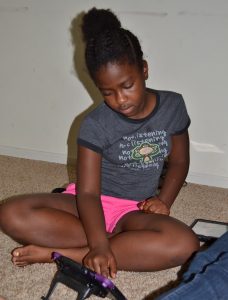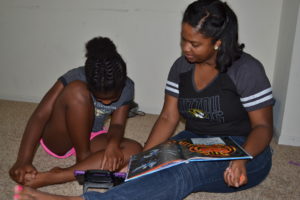
Commercial or custom designed therapeutic devices or equipment commonly referred to as “assistive technology” are used to increase capacity and minimize the functional limitations associated with a developmental disability. The assistive technology equipment can increase the independence of a person with a disability in their home and in the community. Assistive technology includes simple low-tech items such as sensory chewelry (chewable jewelry) and seatbelt covers to more complex items such as adapted bicycles and communication devices. Boone County Family Resources can assist persons served with purchasing these specialized items.
Adora loves to go swimming, listen to music and go out to eat at McDonald’s. When she’s out in the community with her family, she usually takes her Nova Chat, a speech-generating device the size of a small tablet, which enables her to “talk.” Autism and language delays make communication difficult for Adora. She uses sign language, her Nova Chat, and a few vocalizations to communicate with others.
“Adora has been using some sort of communication device since she was around two years old,” says Christina, Adora’s mom. “She has been using the Nova Chat pretty much every day since Kindergarten to express what she wants or needs. Now that she’s a 4th grader, she works on using the Nova Chat to say whole sentences. For example, when she was little, she would select ‘eat’ to tell us she was hungry. Now she uses the device to say, ‘I want to eat.’”
Only using vocalizations when prompted, Adora relies on sign language and her Nova Chat to communicate most of the time. Christina says having the device for Adora has been wonderful. “As you can imagine, Adora would get frustrated when she could not tell us what she wanted. Now she can let us know that she wants a grilled cheese sandwich for dinner or that she would like to watch a video. If anything causes her frustration now, is that she can’t find what she’s looking for on the Nova Chat quickly enough. Sometimes the device itself is her source of frustration.”

A big motivator for Adora to use the Nova Chat consistently is the opportunity to communicate her own choices. Being able to successfully ask to play with Play-doh or a video game rewards Adora with getting to do what she wants. When Adora goes to McDonald’s, Christina asks her to give her food order using her Nova Chat. “Sometimes it takes a little patience on the part of the employee, and Mom,” she says with a smile, “But I think it is also a good customer service lesson for the restaurant to be able to give service to people of all abilities.”
With self-determination being the primary, long-term goal for Adora, Christina said she herself is still learning to encourage choices. “A few weeks ago, my husband and son had something planned together for the day, so I thought it would be fun to have a girls day and go shopping,” said Christina. “Then I thought, no, I’m going to ask Adora to tell me where she wanted to go. She used the Nova Chat to tell me ‘pool.’ So we went to the pool. It turned out to be the best day! She told me her choice and we had a great day.”
Even though Christina says she wishes for a future when Adora can clearly verbalize her choices, she says the Nova Chat has made a big impact on their lives. “It goes pretty much everywhere with us,” says Christina. “When we’re in a grove and using it consistently, it works great for Adora and our family. It is an awesome tool.”
Some other examples of Assistive Technology include talking alarm clocks, hearing aids, visual timers, weighted vests, Lifeline identification tags, door alarms or therapy balls.